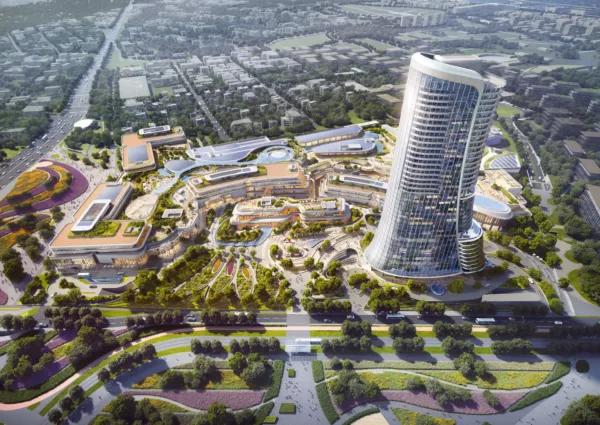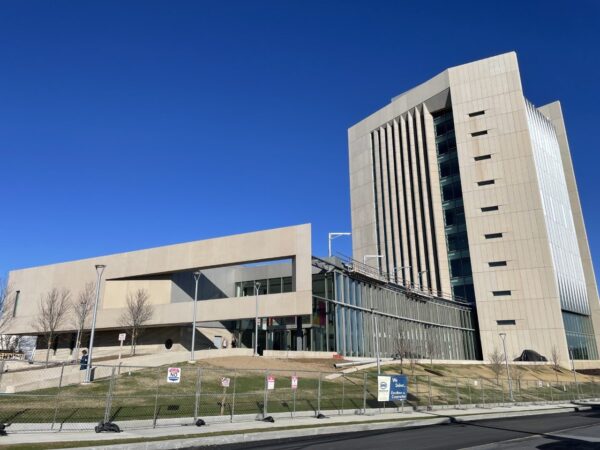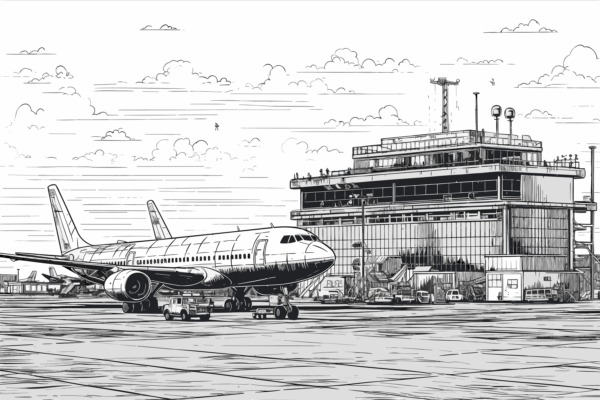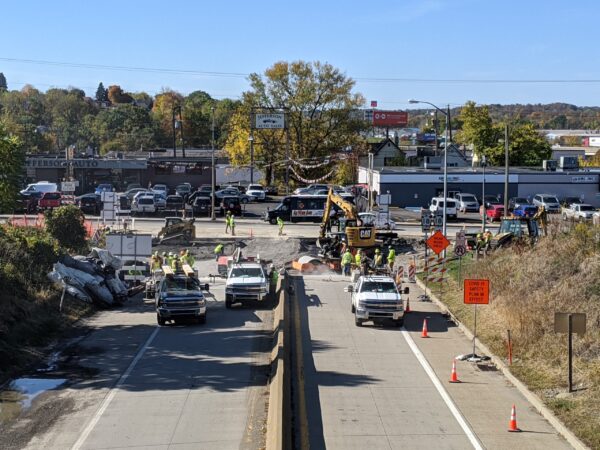

In an age of travel restrictions and scaled back capital programs, the on-time completion of Utah’s Salt Lake City International Airport (SLC) Phase 1 expansion in late 2020 stands out as a welcome exception.
The first step in an ambitious, $4.1 billion program, Phase 1 replaced 3 existing 50-year-old terminals and 5 concourses with a stunning new, 2 million SF single terminal and 2 new concourses. The new facilities provide the latest in amenities and technology to enhance and protect the passenger experience, including new shopping and dining options, vastly increased places to plug in and recharge mobile devices, expanded gate seating, and the latest in intelligent wayfinding systems. The new terminal and concourses are supported by an additional 2 million SF of new support facilities, including a 5-level, 3,600 space parking garage, central utility plant (CUP) and rental car quick turnaround (QTA) and rental service site (RSS), and more than 60 acres of new airfield paving and utilities.
The new terminal is also a testament to SLC’s commitment to sustainability. Designed to achieve LEED Gold certification, the terminal features highly efficient MEP systems, an evaporative cooling system that uses significantly less energy than a traditional climate control system, and the latest in sustainable finishes and fixtures. In addition, SLC is striving to make ground service equipment for the terminal 100% electric—this would make SLC one of the first airports in the world to eliminate fossil fuels entirely from their ground operations.
In addition, the new terminal takes full advantage of Utah’s natural beauty with gallery-style windows providing views of the nearby Wasatch Mountains and natural materials such as native plants and sandstone incorporated throughout. Other aesthetic features include The Canyon and The Falls installations from artist Gordon Heuther. Given these upgrades, the new facilities establish SLC as a destination unto itself.
In keeping with SLC’s status as one of the most cost-efficient airports in the U.S., Phase 1, like the entire program, was funded by federal grants, airport user fees, revenue bonds, and airport reserves, with no local tax dollars required.
The completion of Phase 1 is even more remarkable considering the challenges the program faced: an aggressive schedule, stakeholders ranging from airlines to local utility providers, a shifting regulatory environment, and, of course, COVID-19 all threatened to delay delivery. However, thanks to the commitment of SLC, a proactive management approach, experienced leadership, and formal and informal communications processes and protocols, Phase 1 finished on-time and within budget. Owners should take note, as the tools and techniques used at SLC may well benefit other U.S. capital programs looking to safely and cost-effectively build-out their landside facilities.
Leadership at Altitude
Successful project and construction management requires strong leadership and commitment at all levels of participation. SLC chose to hire seasoned and experienced individuals to form their Project Management Team (PMT). This meant the program had access to subject matter experts (SME) with a clear understanding of the unique constraints and opportunities of large airport capital program construction. The result was safe, on-time completion.
SLC prioritized keeping funding for the project local, and ultimately some 80% of construction costs remained in the greater Salt Lake City metro area, contributing to a local economic impact of approximately $5 billion for the project. SLC’s efforts were evident in the selection of two joint ventures to serve as the Construction Managers at Risk (CMAR) for the project: each joint venture was composed of one local general contractor and one national contractor, and each CMAR team was largely composed of younger talent. The PMT, led by Program Manager Mike Williams of Making Projects Work, Inc., brought decades of airport construction experience. This combination resulted in a symbiotic dynamic where the PMT contributed expertise and guidance to the energy and enthusiasm of the CMAR teams.
Alan Stevens of WSP USA Inc, Deputy Program Manager on the PMT, explained the seamless integration of the team was the key to the project’s success. “People put their corporate identities in the drawer for this project,” he explains. “That’s the only way to make a large program like this work, with everyone working solely towards a shared goal.”
The PMT is composed of SLC personnel as well as seasoned aviation experts from nine national/international consulting companies. This team focused on identifying, capturing, and matching best practices to each phase of the program’s construction. As the building process matured and more and more trade contractors participated, the team implemented an increasingly detailed approach to contractor oversight. This emphasis on evolving control in the field resulted in a shortened punch list and deadlines met, without compromising budget goals.
A Twin-Engine Stakeholder Management Approach
Program stakeholders included major SLC partners, such as hub carrier Delta Air Lines, municipal authorities and leaders, and U.S. Federal regulatory agencies, among others. The team captured all program stakeholders in a formal stakeholder register, documenting priorities, expectations, and contact information.
The PMT then used a two-level approach to keep stakeholders well informed. At the senior level, the PMT held meetings to present progress, strategies, issues, etc.; maintain an open dialogue; and minimize bureaucratic barriers to open communications. The PMT deliberately kept the frequency of these meetings irregular, with daily meetings during intense construction periods and only monthly or bi-monthly meetings when activity was slower. This approach helped to maintain focus and momentum for the duration of the project, while still maintaining information flow.
At the secondary level, the PMT’s individual Area Managers served as the points of contact with outside agencies and established stakeholder meetings where decision makers approved design and construction strategies, documents, etc. In many cases, outside agencies needed to be funded to execute their work elements and the Area Managers would ensure that all parties participated in developing those scopes of work and that they were funded in a timely manner.
Integrating Regulatory Changes
Given the six-year duration of Phase 1, regulatory updates and changes were inevitable, and the Transportation Security Agency (TSA) and U.S. Customs and Border Protection (CBP) Agency were significantly involved in the overall architecture and process flow of the new terminal and concourses. For example, during the finishing and installation period, the CBP adjusted their process to streamline passenger flow, guiding passengers first to baggage claim and then to passport control, rather than vice versa as was previously done. The team responded to this nearly $500 million change with alacrity—reconfiguring and significantly expanding the CBP’s space to accommodate the new flow and without impacting schedule.
Protecting Against COVID-19
The emergence ofCOVID-19 during the Phase 1’s late stages presented an unexpected challenge to on-time completion. The senior management team implemented numerous risk management strategies in anticipation of local, state, and/or federal requirements, mitigating impacts ranging from complete shutdowns to procurement delays and everything in between.
When regulatory guidelines were established to continue work during the pandemic, the senior management team developed a plan, approved by local officials, which then was implemented and tracked by the PMT. First, the team segmented construction into the smallest possible working elements and/or work crews. This minimized and limited potential exposure to the larger work force. If an individual was confirmed with a positive COVID-19 result, this measure meant the outbreak was generally confined to that single, small work crew.
The plan also implemented social distancing, disinfection procedures, and other measures before these steps were widely adopted on other projects. This proactive approach kept COVID-19 impacts to an absolute minimum: out of an approximately 2,500-person peak on-site workforce, quarantine cases were kept to low double digits. Even more impressive, to date there have been zero close contract traces within program, meaning not one case of COVID-19 was transmitted on-site.
Cleared for Phase 2
As the PMT prepares to launch Phase 2 of the program, which provides an additional 1 million SF of concourses, they have codified and organized the lessons learned of Phase 1 into two categories: discipline specific and process improvement. Discipline specific lessons learned, given the composition of the construction and engineering team, reflect the knowledge transfer necessary to leverage the PMT’s expertise to production in the field. Examples of these steps include meetings held to discuss process improvements in mechanical, electrical, IT, civil, and systems disciplines. During Phase 1, these meetings improved the contractor’s submittal quality, reduced turn-around time, and minimized the number of RFIs. They also resulted in a more open and immediate resolution of trade-specific issues and field problems, minimizing cost and/or schedule impacts.
Process improvement lessons learned apply primarily to design and construction management services. One best practice the team established were weekly meetings with the larger project team to identify potential issues, status key elements of each trade contractor’s progress, and barriers to their success. Each team member then identified a resource who was accountable for driving issues to a successful outcome. This practice ensured all participants were constantly aware of their specific commitments.
Phase 2, scheduled for completion in 2024, is well-positioned for success thanks to the PMT’s work in Phase 1. Although all airport projects are unique, and SLC’s new facilities doubly so given their scale and ambition, there are nevertheless several characteristics of the program other airport owners might well consider when executing their own capital programs, especially with the unknowns of COVID-19 still threatening project progress. SLC’s program succeeded in large part thanks to the integrated team, open communications, proven aviation expertise, and proactive approach of the PMT. This same combination can provide owners with increased confidence their projects and programs will be achieved safely, on-time, and within budget.
Photo Courtesy of SLC International Airport
Share

April 11, 2024 | Articles
A Model Move: Managing Move-In at the Sylvia H. Rambo U.S. Courthouse

April 8, 2024 | Articles

April 4, 2024 | Articles
Driving Growth and Seizing Opportunity: Lukasz Marcinkiewicz Joins Hill as Country Manager, Poland

April 1, 2024 | Articles

March 27, 2024 | Articles
Building the Future: Women’s Leadership and Community Engagement in the Construction Industry

March 25, 2024 | Articles
Leveraging Data Analytics and Dashboards for Enhanced Project Performance

February 26, 2024 | Articles
Continuity, Creativity, and Collaboration: Delivering PennDOT’s Route 18 Signal Upgrade
We and use cookies and other tracking technologies to improve your experience on our website. We may store and/or access information on a device and process personal data, such as your IP address and browsing data, for personalised advertising and content, advertising and content measurement, audience research and services development. Additionally, we may utilize precise geolocation data and identification through device scanning.
Please note that your consent will be valid across all our subdomains. You can change or withdraw your consent at any time by clicking the “Consent Preferences” button at the bottom of your screen. We respect your choices and are committed to providing you with a transparent and secure browsing experience.
| Cookie | Duration | Description |
|---|---|---|
| cookielawinfo-checbox-analytics | 11 months | This cookie is set by GDPR Cookie Consent plugin. The cookie is used to store the user consent for the cookies in the category "Analytics". |
| cookielawinfo-checbox-functional | 11 months | The cookie is set by GDPR cookie consent to record the user consent for the cookies in the category "Functional". |
| cookielawinfo-checbox-others | 11 months | This cookie is set by GDPR Cookie Consent plugin. The cookie is used to store the user consent for the cookies in the category "Other. |
| cookielawinfo-checkbox-necessary | 11 months | This cookie is set by GDPR Cookie Consent plugin. The cookies is used to store the user consent for the cookies in the category "Necessary". |
| cookielawinfo-checkbox-performance | 11 months | This cookie is set by GDPR Cookie Consent plugin. The cookie is used to store the user consent for the cookies in the category "Performance". |
| viewed_cookie_policy | 11 months | The cookie is set by the GDPR Cookie Consent plugin and is used to store whether or not user has consented to the use of cookies. It does not store any personal data. |


